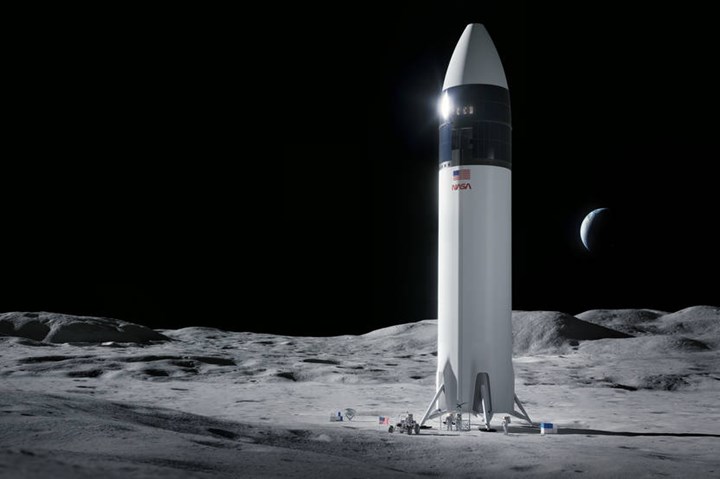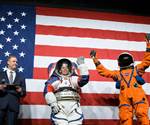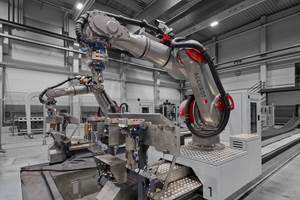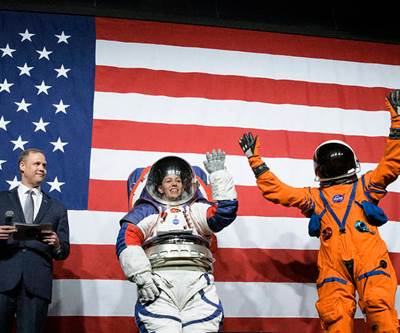NASA selects SpaceX to head human lander development for Artemis moon mission
HLS to act as final mode of transportation to take astronauts to the lunar surface for the Artemis program, with potential future travel to Mars and other destinations.

Illustration of SpaceX Starship human lander design that will carry the first NASA astronauts to the surface of the Moon under the Artemis program. Photo Credit: SpaceX
In preparation to send astronauts to explore more of the moon as part of the Artemis lunar exploration program, NASA has selected SpaceX (Hawthorne, Calif., U.S.) to continue development of the first commercial human lander that will safely carry the next two American astronauts to the lunar surface in 2024. At least one of those astronauts will make history as the first woman on the moon. Another goal of the Artemis program includes landing the first person of color on the lunar surface. SpaceX was one U.S. company chosen out of the three — including Dynetics (a Leidos company, Huntsville, Ala., U.S.) and Blue Origin (Kent, Wash., U.S.)—originally selected in April 2020 to design and develop human landing system (HLS) concepts for the program.
The agency’s Space Launch System (SLS) rocket will launch four astronauts aboard the Orion spacecraft for their multi-day journey to lunar orbit. There, two crew members will transfer to the SpaceX HLS for the final leg of their journey to the surface of the moon. After approximately a week exploring the surface, they will board the lander for their short trip back to orbit where they will return to Orion and their colleagues before heading back to Earth. The firm-fixed price, milestone-based contract total award value is $2.89 billion.
“With this award, NASA and our partners will complete the first crewed demonstration mission to the surface of the moon in the 21st century as the agency takes a step forward for women’s equality and long-term deep space exploration,” says Kathy Lueders, NASA’s associate administrator for Human Explorations and Operations Mission Directorate. “This critical step puts humanity on a path to sustainable lunar exploration and keeps our eyes on missions farther into the solar system, including Mars.”
SpaceX has been working closely with NASA experts during the HLS base period of performance to inform its lander design and ensure it meets NASA’s performance requirements and human spaceflight standards. A key tenet for safe systems, these agreed-upon standards range from areas of engineering, safety, health and medical technical areas.
“This is an exciting time for NASA and especially the Artemis team,” says Lisa Watson-Morgan, program manager for HLS at NASA’s Marshall Space Flight Center in Huntsville, Ala. “During the Apollo program, we proved that it is possible to do the seemingly impossible: land humans on the moon. By taking a collaborative approach in working with industry while leveraging NASA’s proven technical expertise and capabilities, we will return American astronauts to the moon’s surface once again, this time to explore new areas for longer periods of time.”
SpaceX’s HLS Starship, designed to land on the moon, leans on the company’s tested Raptor engines and flight heritage of the Falcon 1 and Dragon 9 vehicles. Starship includes a spacious cabin and two airlocks for astronaut moonwalks. The Starship architecture is intended to evolve to a fully reusable launch and landing system designed for travel to the moon, Mars and other destinations. While SpaceX CEO Elon Musk indicated the Starship’s design was to use stainless steel over carbon fiber back in 2019, the use for composites elsewhere might remain a possibility.
The HLS award is made under the Next Space Technologies for Exploration Partnerships (NextSTEP-2) Appendix H Broad Agency Announcement (BAA).
In parallel with executing the Appendix H award, NASA intends to implement a competitive procurement for sustainable crewed lunar surface transportation services that will provide human access to the lunar surface using the Gateway on a regularly recurring basis beyond the initial crewed demonstration mission.
With NASA’s Space Launch System rocket, Orion spacecraft, HLS and the Gateway lunar outpost, NASA and its commercial and international partners are returning to the moon for scientific discovery, economic benefits and inspiration for a new generation. Working with its partners throughout the Artemis program, the agency will fine-tune precision landing technologies and develop new mobility capabilities to enable exploration of new regions of the Moon. On the surface, the agency has proposed building a new habitat and rovers, testing new power systems and more. These and other innovations and advancements made under the Artemis program will ensure that NASA and its partners are ready for human exploration’s next big step — the exploration of Mars.
Related Content
MFFD longitudinal seams welded, world's largest CFRTP fuselage successfully completed
Fraunhofer IFAM and partners have completed left and right welds connecting the upper and lower fuselage halves and sent the 8×4-meter full-scale section to ZAL for integration with a cabin crown module and testing.
Read MoreDevelopment of a composite liquid hydrogen tank for commercial aircraft
Netherlands consortium advances cryogenic composites testing, tank designs and manufacturing including AFP, hybrid winding, welding of tank components and integrated SHM and H2 sensors for demonstrators in 2025.
Read MoreCombining multifunctional thermoplastic composites, additive manufacturing for next-gen airframe structures
The DOMMINIO project combines AFP with 3D printed gyroid cores, embedded SHM sensors and smart materials for induction-driven disassembly of parts at end of life.
Read MoreAutomated robotic NDT enhances capabilities for composites
Kineco Kaman Composites India uses a bespoke Fill Accubot ultrasonic testing system to boost inspection efficiency and productivity.
Read MoreRead Next
Spacesuits for the next generation
NASA has unveiled two new spacesuit designs that will be used for the Artemis program moon missions.
Read MoreNext-gen fan blades: Hybrid twin RTM, printed sensors, laser shock disassembly
MORPHO project demonstrates blade with 20% faster RTM cure cycle, uses AI-based monitoring for improved maintenance/life cycle management and proves laser shock disassembly for recycling.
Read MoreScaling up, optimizing the flax fiber composite camper
Greenlander’s Sherpa RV cab, which is largely constructed from flax fiber/bio-epoxy sandwich panels, nears commercial production readiness and next-generation scale-up.
Read More


























